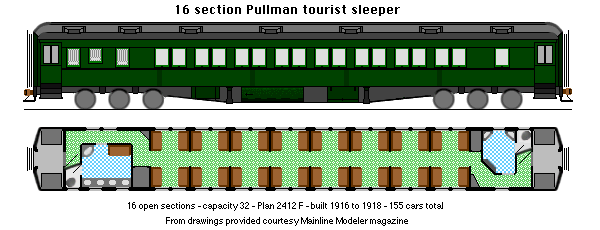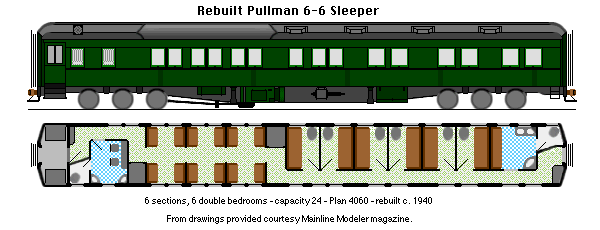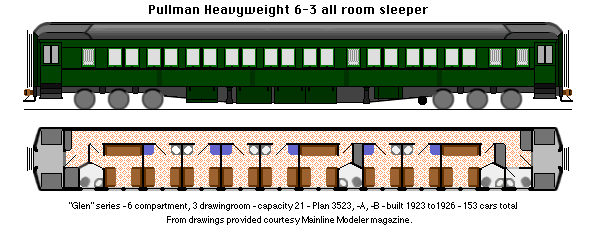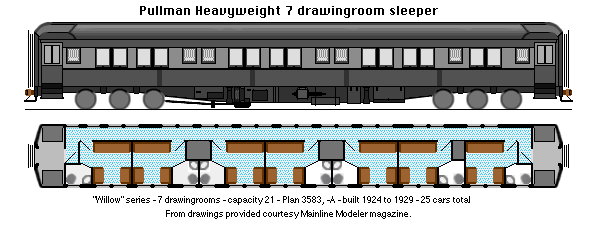
Content provided by Those Classic Trains

Here is where it all began. The first steel passenger cars were 12-1 sleepers, such as this Plan 2410, which are simply a steel adaptation of the "Varnish" Plan 1963 car - "gothic" arched windows and all. 12-1s of the Plan 2410 and 3410 are one of the relatively few steel designs in true mass production: being churned out in 100+ lots for a total over 4000 units: 40% of the entire Pullman steel fleet!
The spread of accommodations is interesting: the lowest level of Pullman space - the open section - together with the best - a drawingroom. Sleeper cars have a relatively low occupancy capacity, and Pullman has long held to the open sections for maximum payload. The drawingroom on 12-1s is actually intended for families: the High And Mighty prefer all-room cars.
Some typical features of these cars are the two large restrooms (the mens room - at left - is also the smoking lounge while the ladies have a vanity table in their restroom).
The drawingroom has an arrangement similar to the sections, plus a sofa which makes up into a third berth. The drawingroom, of course, has its own facility.
Externally we see that the traditional clerestory vents have been replaced with the new sheet metal ventilators. These use the forward motion of the car to create a draft through the fore-and-aft openings which, in turn, causes a venturi effect drawing fresh air into the car through the center openings.
The specific car shown here is the Plan 2410. The 2410-A is similar. So rapid is the evolution in car design that these "Gothic" cars will be superseded by the Plan 2410-B standard heavyweight by 1914. However, so rapid is the production of these cars that 910 of the Plan 2410 and 390 Plan 2410-A were built. That is 1300 cars total, or an average of one car a day, every day, for 3-1/2 years.
A great many of these "Gothic" 12-1s will be rebuilt into chair cars, sleeper-buffets and all room cars in the 1930s.

By 1913, the design has evolved into the standard all-steel riveted car that has come to be known as the "Heavyweights" or - sometimes - as the "Battleships". This Plan 2412 16 section car is typical of the basic Pullman accommodation available in the first quarter of the 20th Century. If anything, the 16 section car has a lower status than the 12-1. Cars of this type (some 350 of various subtypes were built) are used on tourist trains and the anonymous regionals.
Occupants will be Government employees (Washington will only reimburse for a lower section), drummers (who live on these cars for months as they make their sales routes) and anyone who wants to ride at the lowest possible cost. With 16 upper berths, the Porters stepladder must be constantly in use!
The facilities are an indication of the times: note that the mens room (at left) is much larger than the ladies room. Evidently women do not travel as often. However, for its modest status, these are still Pullman cars and all the amenities such as plush seats, carpeting, starchy linen sheets and an attentive Porter are right there.
One should be careful not to confuse the 16 section car with the 14 section car. 16 sections are an early design: production had ended by 1918. The 14 section tourist sleeper came later when many of the "Gothic" 12-1s were rebuilt for economy trains. 14 section cars have more room in the lounges and are generally more comfortable than the earlier 16s.

By the 1930s, demand for open sections is dropping. With the Great Depression in full tide, travel is down across the board. At the same time, these new fangled automobiles are starting to take ridership away in significant numbers. To answer this challenge, Pullman has begun rebuilding some of its earlier section cars into cars with more private room accommodations.
This is a fairly typical design: one of two similar 6-6 Plans. At left are a reduced number of traditional sections, while at right are several of the new double bedrooms. These are private rooms with a sofa that folds down into a berth. As with the open section, the upper folds down from the roof, although here, the berths are turned crosswise to the car.
Each double bedroom has a private toilet and a fold-down steel sink. This is a less than elegant arrangement, however, as there is no privacy for using the toilet and because it sticks right out into the middle of the room.
Externally, we see one of the new air conditioning systems that are starting to appear. This is the Pullman Mechanical system, which is driven by a belt drive off one truck and uses ammonia as a refrigerant. The air conditioner ducting is a retrofit on the existing clerestory roof. Here we see the typical Pullman practice of only running this duct over the seating areas: the halls and restrooms are not air conditioned. The hallway still relies on clerestory ventilators while the mens room has a new electrically driven exhaust fan. Interestingly, on the opposite side of the car, the air conditioning duct runs the full length of the roof.
Another significant feature is that this car has only one vestibule. Double vestibules are a tradition going back to the earliest passenger cars. However, the industry has come to the conclusion that only one vestibule per car is needed on sleepers, and the room thus saved can be put to revenue use. This will become the norm in the Lightweight era.
In the years between 1925 and 1940, hundreds of former section sleepers will be converted into a variety of section and room combos. With these come several new types of accommodation. In addition to the traditional open section and drawingroom, there are now the single bedroom (no upper berth), double bedroom and the compartment.
Other common types of room and section cars include the 8-1-2, 8-3-1, 10-2, 10-1-2, 10-1-1, 10-3, and the 8-5.

All-room sleepers have been around since the "Varnish" days, in small numbers and on certain elite trains. By 1920, however, the demand for improved service has led to more all-room cars such as these "Glen" series 6-3s. Broadly speaking, all-room cars have been built in small numbers. The 6-3 is the exception to this rule, with 203 units on the roster; all of them standard Heavyweights.
The design shows some improvements in the accommodations. The compartments still have the open toilets, but they are discretely hidden under a fold-down top. In place of the steel fold-down sink, a fixed sink is provided opposite the toilet. The compartment being larger than a bedroom, these are also move conveniently placed.
This particular car demonstrates the iced air conditioning system with its enormous ice boxes taking up most of the room on the underframe. Note how the air conditioning duct runs the length of the car on this side: on the opposite side, over the hallway, there is no duct at all.

The ultimate expression of all-room luxury are these 7 drawingroom sleepers of the "Willow" series. These top-line accommodation cars, which might be dubbed "deluxe all room cars" are built in small numbers and used on the premiere trains such as the "Broadway", "20th Century Limited", the Santa Fe "Deluxe" and connections on the major long distance routes.
The 7 Drawingroom car actually dates back to the "Varnish" days when a handful of them were built for premiere service to the Southwest. A mere 4 units were built as "Gothic" Plan 2583 and 2583-A. The 10 cars of Plan 2583-B and the 25 cars of Plan 3583 and 3583-A are the entire lot of standard Heavyweight designs: 39 units total.
Small batches of "deluxe" all-room heavyweight cars have also been built in 10 compartment (a New York Central tradition), 7 cpt-2 dwgrm (widely used), 14 single bedroom and 13 double bedroom (NYC and PRR among others) as well as ones and twos of other all-room designs built for special applications.
This car is showing the late Pullman standard two-tone gray scheme which started to replace the traditional Dark Olive Green in the mid 30s. Also note that the underframe is becoming quite crowded; so much so that the reservoirs have had to be suspended on mounts to clear the dual brake system. Underbody goodies include the PMB a/c system, twin battery boxes (one on each side) twin brake rigging, center mount spline-drive generator, water tank (opposite side) and winter covers box.
Note, too, that the design has reverted to the double vestibules. One does not want to keep the Plutocrats standing in line.
Refer to "Free Downloads" for a summary of Pullman car types.
| Home Site Map Search Contact |
North East Rails © Clint Chamberlin. |